Top Forex Brokers
The difference between success and failure in Forex / CFD trading is highly likely to depend mostly upon which assets you choose to trade each week and in which direction, and not on the exact methods you might use to determine trade entries and exits.
So, when starting the week, it is a good idea to look at the big picture of what is developing in the market as a whole, and how such developments and affected by macro fundamentals, technical factors, and market sentiment. There are several strong long-term trends in the market right now, which might be exploited profitably. Read on to get my weekly analysis below.
Fundamental Analysis & Market Sentiment
I wrote in my previous piece on 11th June that the best trade opportunities for the week were likely to be:
- Long of the NASDAQ 100 Index. The Index ended the week higher by 3.98%.
- Long of the USD/JPY currency pair following a bounce at a key support level like ¥139.05. The low of the week was just a few pips below that level, so there was an opportunity to make a profitable trade of about 2 units reward to 1 unit of risk.
- Long of the GBP/USD currency pair. This ended the week higher by 1.94%.
- Long of Cocoa Futures. CC1! ended the week higher by 2.41%
My forecast produced an overall quantifiable win of 7.33%, averaging a gain of 1.83% per highlighted asset, which was an excellent weekly performance.
The market is most focused now on the aftermath of last week’s lower-than-expected US CPI (inflation) data (falling from an annualized rate of 4.9% to 4.0%, less than the 4.1% which had been expected) and the Fed’s first rate hike pause in many months, although it is seemingly clear that there are more Fed rate hikes to come, probably as early as next month. The Bank of England and the Swiss National Bank will be holding policy meetings over this coming week, and they will be watched closely to see whether they both hike rates as expected by 0.25%.
Another major item is the continuing strong bull market in stocks, to some extent globally, but particularly in the USA, where the S&P 500 Index and the NASDAQ 100 Index both new 1-year high prices. The question is, will the US economy fall into recession and by how much more will the Fed hike, and what impact will this have on the stock market? The Fed is anyway widely expected to hike again in July, and the terminal rate is approaching a level where the risk-free return is not far from the average annual return of the stock market. However, it should be remembered that real interest rates are barely 1% in the USA once inflation has been accounted for, so the kind of returns we are seeing in the stock markets this year are very attractive to investors. The NASDAQ 100 Index is up by approximately 40% since the start of 2023, while the S&P 500 Index is up by more than 15% over the same period.
Last week’s other key data releases were:
- European Central Bank Main Refinancing Rate and Monetary Policy Statement – this produced a hike of 25bps as expected.
- Bank of Japan Policy Rate and Monetary Policy Statement – the ultra-loose monetary policy was maintained, leading to a further weakening of the Japanese Yen.
- US PPI declined by 0.3%, further than expected, reinforcing expectations that inflation is now falling hard in the USA.
- US Retail Sales – this came in exactly as expected.
- US Preliminary UoM Consumer Sentiment – a little higher than expected, suggesting consumer demand is still a little high.
- Chinese Industrial Production – showing a year-on-year increase of 3.5% as expected.
- UK GDP – a month-on-month increase of 0.2% as expected.
- New Zealand GDP – a decline of 0.1% over the past quarter as expected.
- US Unemployment Claims – a little higher than expected.
- UK Unemployment Claims (Claimant Count Change) – a little lower than expected.
- Australian Unemployment Rate – the rate unexpectedly decreased from 3.7% to 3.6%.
The Week Ahead: 19th – 23rd June
The coming week in the markets is likely to see a lower level of volatility than last week, as there will be much less high impact and central bank data releases, although we will see policy meetings at the Bank of England and at the Swiss National Bank. This week’s key data releases are, in order of importance:
- Bank of England Official Bank Rate & Monetary Policy Summary
- Swiss National Bank Policy Rate and Monetary Policy Assessment
- Fed Chair Powell testifies before Congress.
- UK CPI (inflation) data
- US Unemployment Claims
- Flash Manufacturing Services & PMI in the USA, UK, Germany, and France
Monday will be a public holiday in the USA, and there will be a public holiday in China on Thursday and Friday.
Technical Analysis
US Dollar Index
The weekly price chart below shows the U.S. Dollar Index printed a relatively large bearish candlestick last week, in line with its long-term bearish trend. This was the biggest weekly fall in the greenback since January earlier this year.
The Dollar remains within a technically valid long-term bearish trend, with its price lower than it was both 3 and 6 months ago. Another bearish factor we see this week is the invalidation of the former support level at 102.801, which previously acted as firm support. We also see a pattern of lower highs over recent weeks.
I think it will make most sense to trade against the US Dollar over the coming week, except perhaps in the case of the USD/JPY as the Japanese Yen is so weak.
Weakness in the greenback firmed this week as the Federal Reserve passed on a rate hike for the first time in many months.
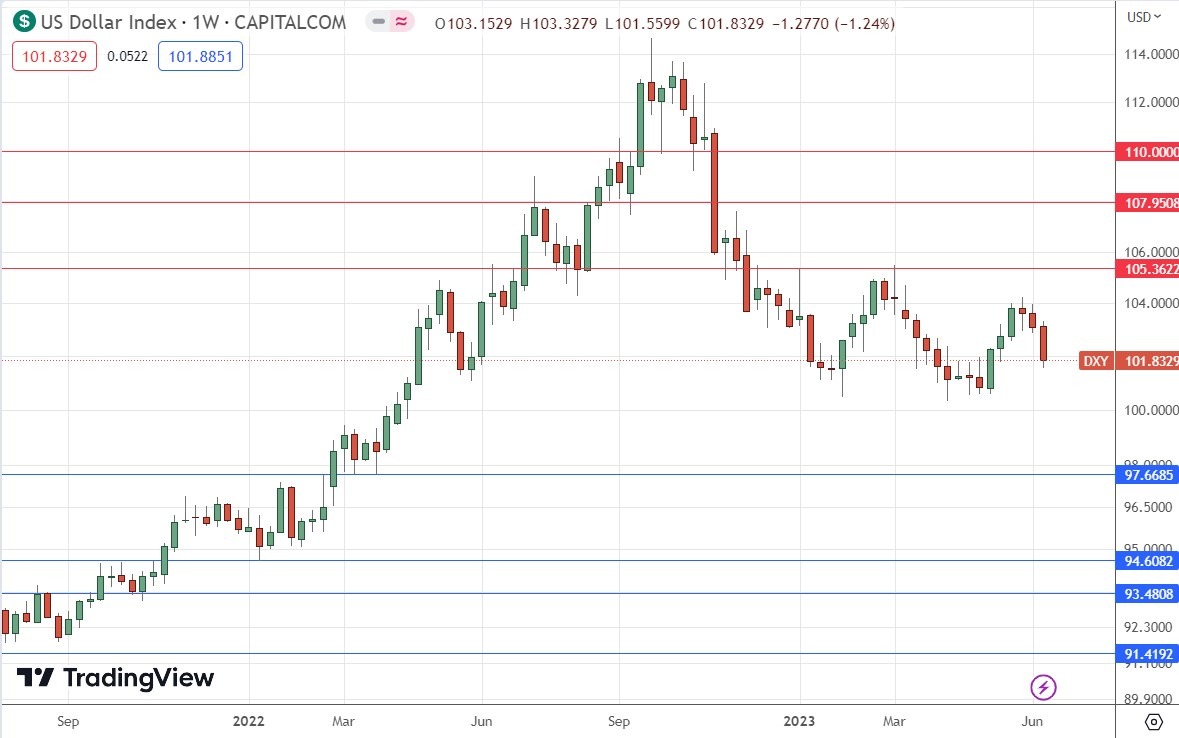
NASDAQ 100 Index
We saw a strong rise in the NASDAQ 100 Index over the past week, making the eighth up week in a row. The picture here looks very bullish, with the market running away to the upside and having already risen by about 40% this calendar year before the year is even halfway over.
There are several bullish factors persisting:
- The weekly candle closed higher, at its highest closing price seen in over one year, for the fifth consecutive week.
- The weekly candlestick closed not far from its high price.
- Stock markets are generally bullish, and the S&P 500 Index is also technically bullish, but less so, ending last week at a new 1-year high price, after having confirmed a bull market by all common metrics during the previous weeks.
- The Fed passed on a rate hike, boosting stocks.
However, there is one reason for bulls to be cautious over the coming week: the price has run into a resistance level at 15156.2 which has held.
The NASDAQ 100 Index still looks like a buy to me, but only following a firm daily close above 15156.2.
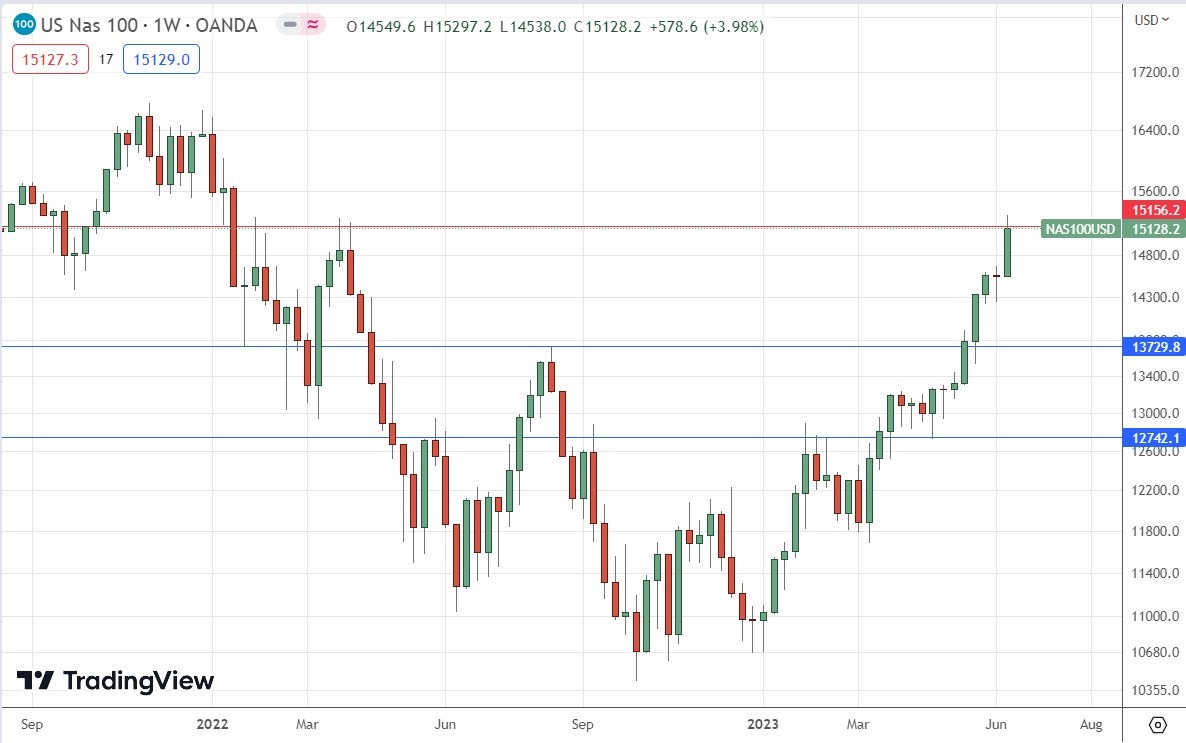
USD/JPY
The USD/JPY currency pair rose firmly last week to make its highest weekly close in 7 months, ending the week right on its high. These are bullish signs.
However, the US Dollar overall cannot be said to be in a long-term bullish trend, so there is some conflict here. The upwards movement is due to the very weak Japanese Yen, which has fallen even harder over the past week against other currencies such as the Australian Dollar and the British Pound.
The Bank of Japan stuck to its ultra-loose monetary policy at its policy meeting last week.
As a trend trader in major currency pairs, I am long of this currency pair and want to remain long unless we see a big drop. However, the case for this long trade is getting weaker, especially now that the Fed passed on a rate hike last week.
This currency pair looks like a buy if it retraces to a key support level and bounces firmly there, notably at ¥140.79.
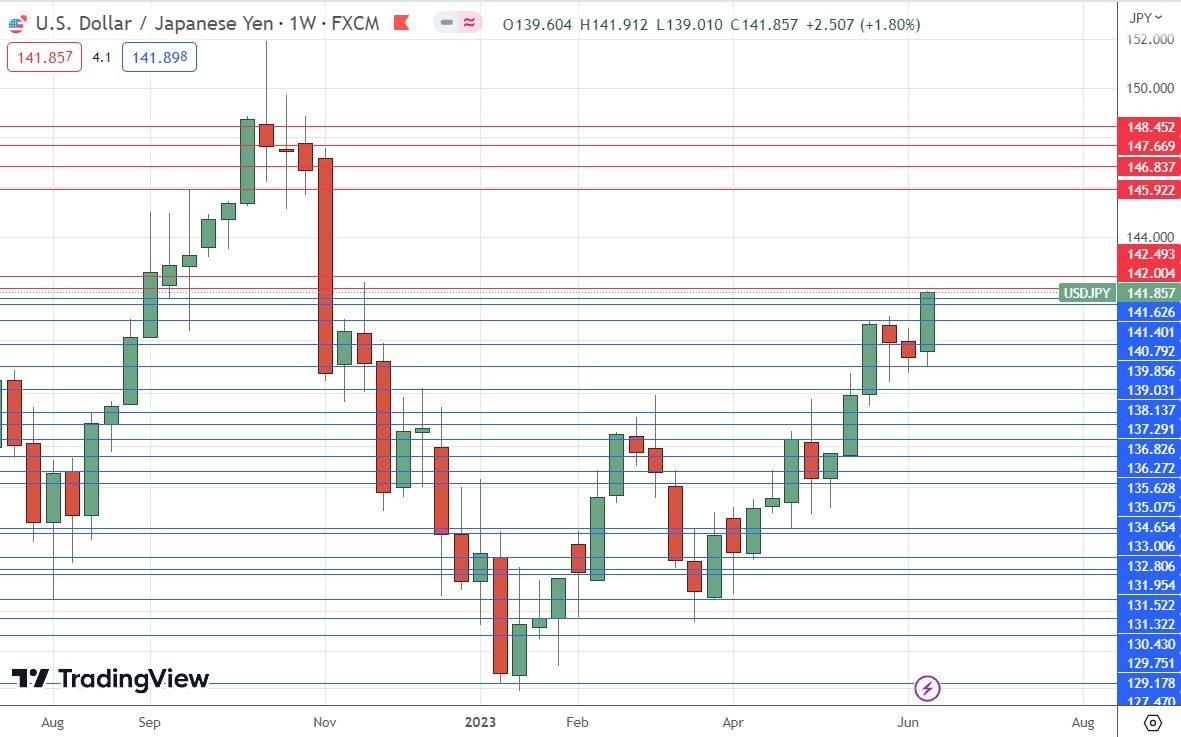
GBP/USD
The GBP/USD currency pair printed a strongly bullish candlestick that closed near the high of its range, which is a bullish sign. This was the strongest weekly rise seen here since November 2022. The British Pound is standing out as a relatively strong currency.
The Pound is in a long-term bullish trend, and the US Dollar is weak. The price hit a new 1-year high last week.
Technically, we see strong bullish momentum, which is backed by fundamental analysis as we see hints of a divergent policy between the US Federal Reserve and the Bank of England, with the BoE looking more hawkish while the Fed passed on a hike at its meeting last week. The Bank of England is expected to raise its interest rate by 0.25% this week.
This pair is usually good to trade on breakouts, and as we see the price running up hard to new highs, this currency pair looks like a buy.
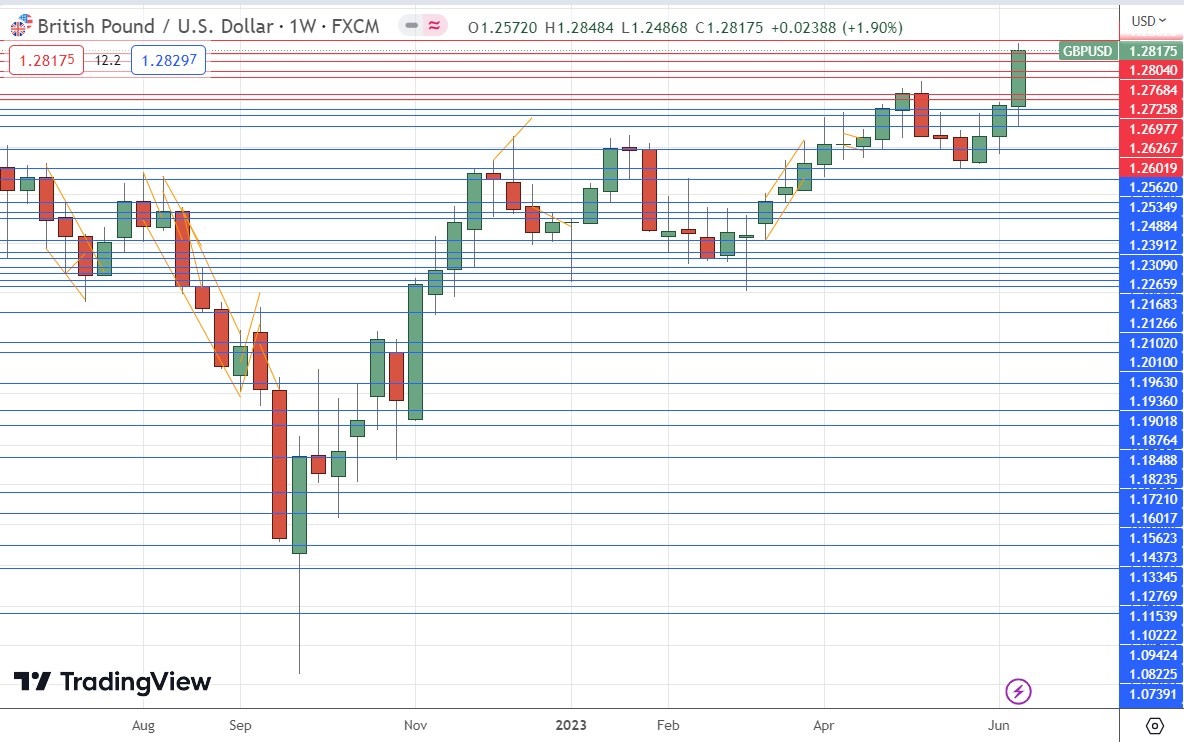
AUD/USD
The AUD/USD currency pair made a strong bullish breakout last week, finally overcoming the area of strong resistance around the big quarter number at $0.6750 which had held firm over several weeks. The Australian Dollar is standing out as a relatively strong currency, in fact it is now the strongest major currency.
We do see bullish momentum here, triggered partially by the Fed’s passing on a US rate hike last week, while recovering risk appetite and some strongly rising stock markets are helping to boost the Aussie.
Despite these bullish factors, it should be noted that the price is not trading in bullish blue sky and was held by a resistance level confluent with the round number at $0.6900.
I do not have a strong feeling that the price will rise over the coming week, but I would not want to be short of this currency pair either.
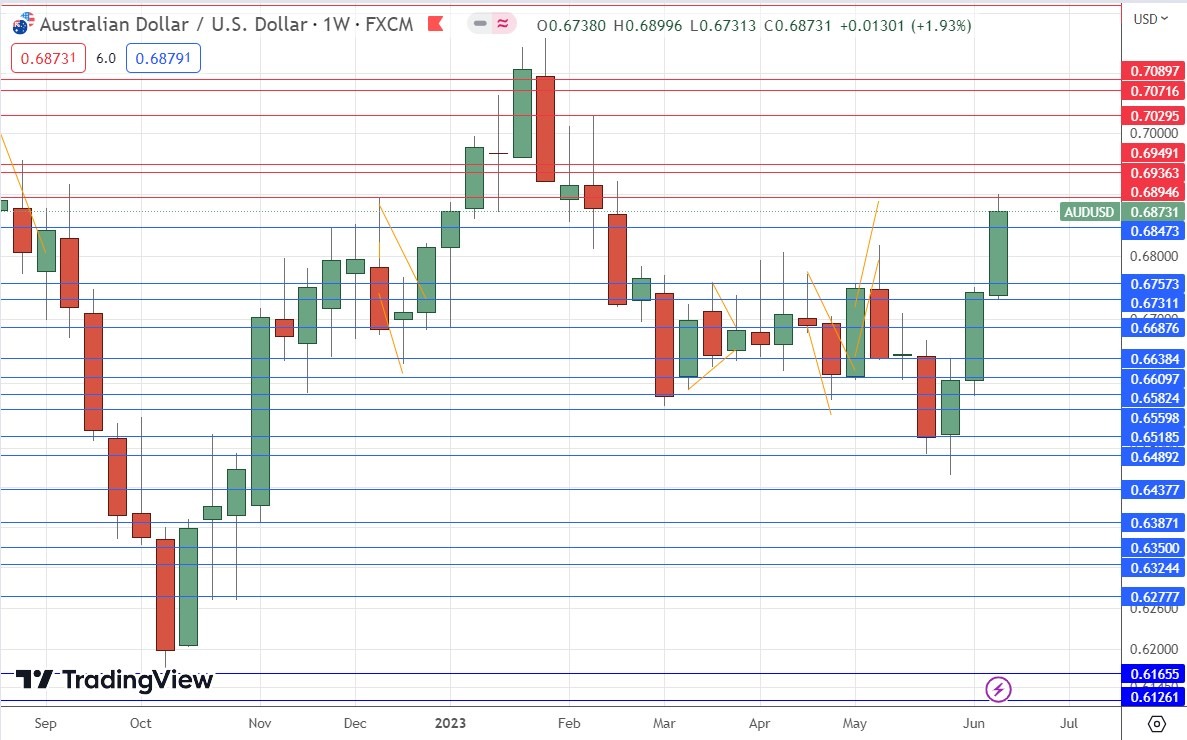
Cocoa Futures
Cocoa futures powered to a new multi-year high price, closing not far from the high of the week’s range. The price chart below shows what a steep and orderly, strong bullish trend this has been, with the price contained neatly by a powerful linear regression channel over the last 40 weeks or so.
There is strong demand for cocoa, as always, but there are supply issues, and there are increasing expectations of a poor crop in the Ivory Coast this year.
This trend is arguably very mature, so buying now could be risky. However, the strength of the bullish momentum here is so strong that it is tempting to become involved, and trend traders will probably not want to miss out on this long trade.
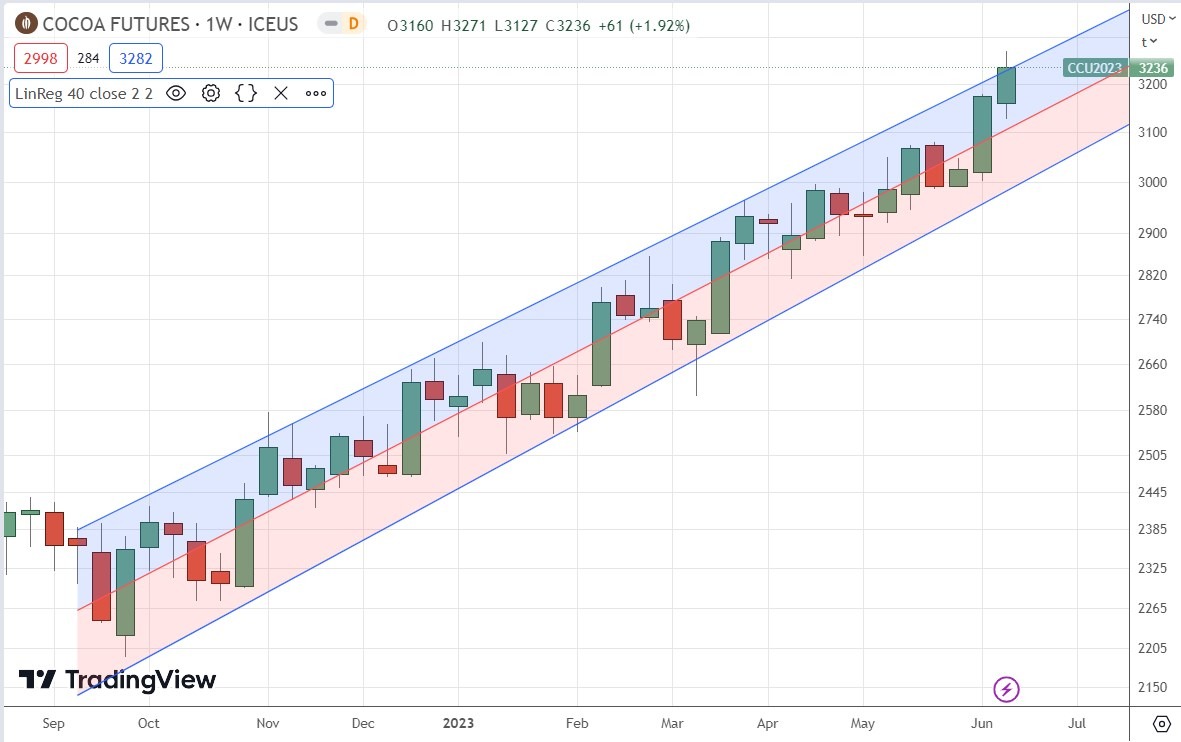
USD/MXN
The USD/MXN currency pair is in a powerful long-term bearish trend, as can be seen in the price chart below.
The weekly candlestick was of an average though healthy size, closing quite near the low of its price range. The price reached a 7-year low, which is significant.
The health and predictability of this trend is emphasized by the 40-week linear regression channel which contains the trend price action nicely. This suggests that the trend is relatively likely to be stable and therefore to continue.
Although the US Dollar is in a definite bearish trend, the strength of the Mexican Peso is unusual, driven by strong export growth and an onshoring trend by Mexican-sourced services and industries.
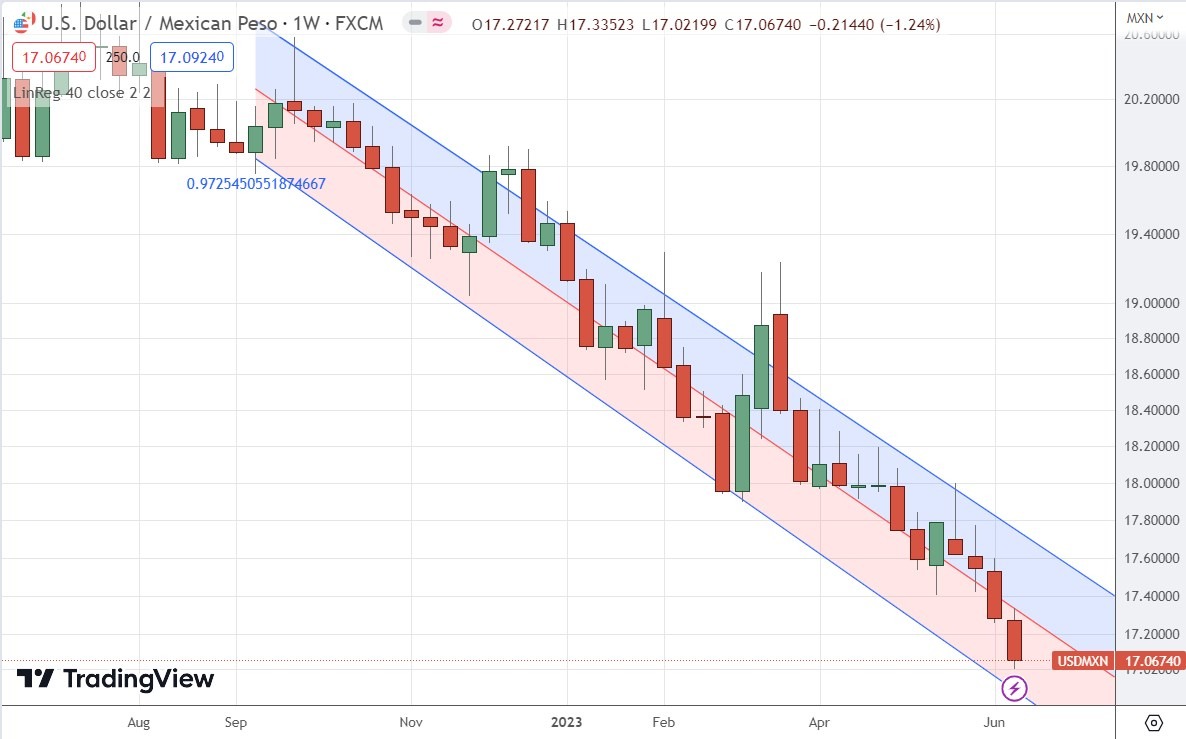
Bottom Line
I see the best trading opportunities this week as:
- Long of the NASDAQ 100 Index.
- Long of the USD/JPY currency pair following a bounce at a key support level like ¥140.79.
- Long of the GBP/USD currency pair.
- Long of Cocoa futures.
Ready to trade our weekly Forex forecast? Here are the best Forex brokers to choose from.
